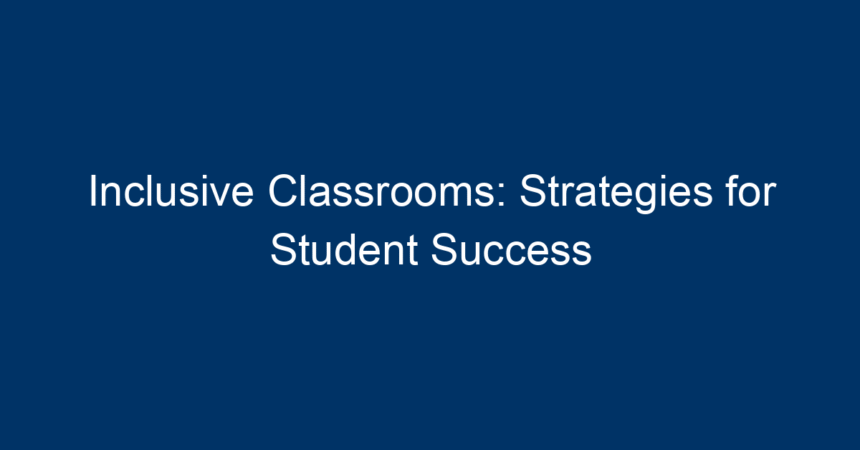In today’s educational landscape, embracing diversity and fostering inclusive classrooms is more crucial than ever. An inclusive classroom is one where every student, regardless of their background or abilities, feels welcomed, respected, and valued. As educators face the pressing need to address varying learning styles, disabilities, and cultural differences, developing effective strategies to create inclusive environments is paramount. This article will explore practical, actionable strategies for achieving success in inclusive classrooms, helping to create supportive learning environments for all students.
Understanding Inclusive Classrooms
What Are Inclusive Classrooms?
Inclusive classrooms are designed to accommodate students with diverse needs, including those with disabilities, different cultural backgrounds, and varying learning styles. In such settings, teaching methods and resources are adapted to ensure that all students can fully participate in the educational process.
Benefits of Inclusive Classrooms
- Enhances Social Skills: Students learn empathy, cooperation, and communication by interacting with peers from various backgrounds.
- Improved Academic Outcomes: Research shows that inclusive practices often lead to better academic performance for all students.
- Promotes Acceptance: An inclusive environment fosters respect for differences, paving the way for a more tolerant society.
Strategies for Creating Inclusive Classrooms
To ensure success in inclusive classrooms, educators must implement targeted strategies that cater to the diverse needs of their students. Here are some effective approaches:
1. Differentiated Instruction
Differentiated instruction involves tailoring lessons to meet diverse learning needs. Here’s how to implement this strategy:
- Varied Content Delivery: Use multiple formats (videos, hands-on activities, readings) to present information.
- Flexible Grouping: Change student groups based on the activity—sometimes grouping students by ability, and at other times by interest or collaborative potential.
- Tailored Assessments: Create varied types of assessments catering to different learning styles, such as projects, presentations, or traditional tests.
2. Collaborative Learning
Collaboration among students enhances communication and builds team-working skills. Implement collaborative learning through:
- Group Work: Assign students to work in diverse groups, allowing them to learn from each other’s strengths.
- Peer Tutoring: Encourage students to support one another, which can foster a deeper understanding of content.
- Shared Goals: Set common objectives for group projects to ensure all students contribute equally and benefit from the learning experience.
3. Use of Technology
Incorporating technology in inclusive classrooms can address multiple learning needs effectively. Consider these tools:
- Interactive Whiteboards: Use technology to create visual and engaging lessons that cater to diverse learning styles.
- Learning Management Systems: Platforms like Google Classroom can help organize resources, assignments, and communications that are accessible to all.
- Assistive Technology: Tools like speech-to-text software, audiobooks, and other accessible resources can support students with disabilities.
4. Classroom Environment
A nurturing and safe classroom environment is critical for promoting inclusiveness. Steps to consider include:
- Flexible Seating: Arrange seating to promote collaboration and movement, accommodating different learning preferences.
- Visual Aids: Use charts, diagrams, and models to support visual learners and reinforce concepts.
- Culturally Relevant Materials: Include books, resources, and activities that reflect the diverse cultures within the classroom to validate students’ identities.
5. Strong Classroom Management
An effective classroom management strategy can enhance inclusivity by creating a safe learning environment for all students. Here are essential tips:
- Clear Expectations: Establish and communicate clear behavioral expectations from the start.
- Positive Reinforcement: Recognize and celebrate achievements, whether big or small, to build a positive classroom culture.
- Routine and Consistency: Incorporate predictable routines so that students feel secure and understand what to expect each day.
6. Parental and Community Involvement
Involving parents and the community can significantly enhance the inclusivity of classrooms. Strategies include:
- Regular Communication: Keep parents informed about their child’s progress and classroom activities through newsletters, emails, or parent-teacher conferences.
- Family Engagement Activities: Organize events that encourage family participation, such as multicultural nights or educational workshops.
- Community Partnerships: Collaborate with local organizations to provide additional resources and support systems for students and families.
7. Professional Development for Educators
Educators must be equipped with the knowledge and skills necessary for creating inclusive classrooms. To maximize effectiveness:
- Training Sessions: Regular workshops on inclusive teaching strategies, differentiation, and cultural competence are essential.
- Peer Collaboration: Foster a culture of sharing best practices among teachers through mentoring or group sessions.
- Feedback Loops: Establish spaces for teachers to share successes and challenges; this reflective practice can enhance pedagogy.
Challenges in Creating Inclusive Classrooms
While the benefits of inclusive classrooms are clear, educators may face challenges, including:
- Limited Resources: Insufficient funding for special education services and assistive technology.
- Resistance to Change: Some educators may be hesitant to modify their teaching styles or embrace new practices.
- Behavioral Issues: Managing diverse behavioral needs can be complex and overwhelming for many educators.
Conclusion: Steps Toward Successful Inclusive Classrooms
Creating inclusive classrooms is an ongoing journey that requires commitment, creativity, and collaboration. By implementing tailored strategies such as differentiated instruction, collaborative learning, and engaging technology, educators can meet the diverse needs of their students.
Actionable Insights:
- Assess Your Classroom: Regularly evaluate your classroom environment and instructional practices to identify areas for improvement.
- Engage with Families: Develop strong relationships with families to ensure a supportive network for all students.
- Foster a Community of Learning: Create spaces for teachers to share experiences, insights, and resources, strengthening the collective approach to inclusivity.
By embracing the principles of inclusivity, educators not only enrich the learning experiences of their students but also contribute to a more equitable and compassionate society. As we progress towards building more inclusive classrooms, remember that every small change can lead to a significant impact on student success.




